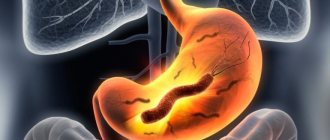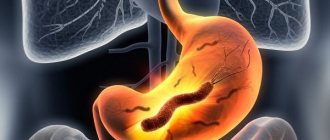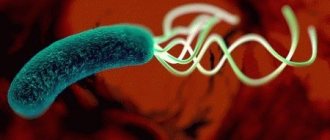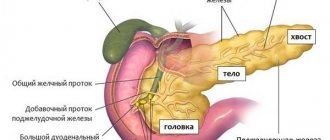Parents face a difficult task. After all, if dietary dishes cause rejection and stress reactions in the child, this will only aggravate the problem.
Meanwhile, statistics indicate the widespread prevalence of juvenile (children's) gastritis. Among all diseases of the gastrointestinal tract, chronic gastroduodenitis accounts for 45% in primary schoolchildren, 73% in middle school students and 65% in adolescents. At the same time, the decrease in the incidence rate among schoolchildren of the older age group is associated with the transformation of the inflammatory process into peptic ulcer disease.
What can a child do if he has an inflammation of the stomach?
There are no significant differences in dietary recommendations for children and adults. The basic principles of rational nutrition remain the same, but are supplemented with some nuances:
- Compliance with the regimen and frequency of meals. Meals should be 4-6 times a day, not too plentiful, so as not to cause a feeling of overeating. It is very important to explain to the child the need to arrive on time for lunch or afternoon snack after a walk, and to organize adequate nutrition at school or preschool educational institutions.
- Thermal, mechanical, chemical sparing of the affected organ. It is necessary to exclude from the diet all products containing substances that irritate the stomach: fried foods (including French fries), fast food, chips, spices, chewing gum, store-bought juices that are full of preservatives, flavorings, and flavor enhancers. Any carbonated drinks are prohibited due to the negative effect of carbon dioxide on the mucous membranes, as well as confectionery products. Cakes, pastries, and pastries are considered difficult-to-digest, heavy foods, and ice cream is considered too cold a product for sensitive mucous membranes. It is better to replace all these desserts with fruits, jellies, puddings, savory pastries, marshmallows or marshmallows, and ice cream with a milkshake with added fruit.
- Giving visual appeal and positive taste to dietary dishes. This is especially important for younger children, for whom the concepts of “beautiful” and “tasty” are on the same plane.
- Providing the growing body with a complete set of nutrients adequate to age-related needs. On this point, general dietary recommendations for gastritis vary somewhat for different age groups.
Basic principles of nutrition for gastritis
In the treatment of such patients, special importance is attached to the dietary table, its characteristics and accuracy of compliance. It depends on him how quickly the child recovers. In addition, properly selected nutrition has a beneficial effect on the functioning of the gastrointestinal tract between relapses of gastritis in children, increasing the interval between exacerbations in the chronic course of the disease.
There are certain recommendations for patients undergoing diet therapy. Regardless of whether it is a child, a nursing mother or an elderly person:
- You need to eat in small portions. This is necessary in order to establish the secretory activity of the stomach, so regular meals 5-6 times a day instead of two or three large feasts is the golden rule for any gastroenterologist patient, especially a child.
- Products must be of good quality and fresh. It is unlikely that anyone would think of treating a sick child to smoked meats, but, nevertheless, do not forget that fatty, fried foods, cooked in large amounts of oil or not properly heat-treated, are categorically excluded.
- Food should not irritate the gastric mucosa. For this purpose, it must be brought to a homogeneous consistency by steaming or in water. In no case should the product be hot or cold; optimally its temperature should correspond to the child’s body temperature, that is, be pleasantly warm.
- Balanced table. A ban on certain foods does not mean that you need to give up delicious food. On the contrary, a diet for gastritis in children over 4 years old includes a large assortment of first and second courses, snacks and sweets, and the child will receive everything necessary for healthy growth and development.
The more acute the condition, the more strictly these recommendations should be followed. Then, as the painful syndrome decreases and after inflammation is relieved, you can gradually expand the baby’s diet.
Nutrition for 4-6 years
During an exacerbation, diet No. 1a according to Pevzner is recommended, including liquid, semi-liquid, pureed dishes.
The daily calorie content of this diet is at the lower limit of the norm, so as not to overload the stomach. It is not advisable to eat this way for more than 3 days. After completion of the most acute stage of the disease, diet No. 1b is recommended. The basic principles of nutrition (chopped warm, gentle food) remain the same, the diet is slightly expanded, and the overall energy value of the dishes increases. This diet is more complete and balanced, so if necessary, it can be followed for up to one and a half months.
After the onset of remission, the little patient is gradually transferred to table No. 1 for hyperacid gastritis. It is permissible to reduce the frequency of meals and increase the calorie content of dishes. There is no longer any need to grind everything into a puree, and serve the meat only as minced meat. However, you need to explain to your baby the need to chew food thoroughly and take your time while eating. Products that stimulate gastric secretion (most raw vegetables, fruits, chocolate, cocoa, smoked foods) are prohibited.
If the acidity of gastric juice is reduced (which is quite rare at a young age), then it is advisable to transfer the baby to table No. 2, which involves eating lighter, more quickly digestible foods (vegetables without coarse fiber, lean meat and fish).
Advice from experienced parents. It is better to explain to children the importance of therapeutic nutrition in a playful way. For example, you can compose and act out a fairy tale about a sick stomach that feels bad when chocolates or cakes come to visit. And then show how the stomach rejoices at meeting milk, potatoes, and apples.
The daily calorie content of diet No. 1 for children 4-6 years old with gastritis is 2084 kcal, protein content - 71 g, fat - 75 g, carbohydrates - 281 g.
Sample menu for a child: Tables No. 1 and No. 2
For dietary therapy of gastritis, treatment tables No. 1, 1a, 1b, No. 2 are recommended.
- Dietary table No. 1 is prescribed for chronic gastritis with high acidity for 6-12 weeks, outside the period of exacerbation.
- Dietary table No. 2 is recommended for the treatment of gastritis with low acidity.
Table No. 1 is quite high in calories, the energy value is 2800 kcal. Contains fats, proteins and carbohydrates in physiological norm. The dishes included in this therapeutic diet have a moderate, gentle effect on the gastric mucosa. The patient is recommended to eat 5-6 meals a day at three to four hour intervals. Prescribed for 4-6 weeks or more.
You can include in your diet stewed and baked dishes, dried white bread, biscuits, non-acidic cottage cheese and kefir, sour cream sauce, steamed fish and meat dishes, durum vermicelli, and baked fruits. You can eat homemade baked goods with meat or fruit filling no more than once a week.
| Sample menu for prescribing dietary table No. 1 | |
| Breakfast | pureed buckwheat porridge with milk, steam omelette, weak tea |
| Lunch | baked apple |
| Dinner | pureed vegetable soup, steamed meatballs, vegetable puree with butter or sour cream sauce, milk jelly |
| Afternoon snack | crackers, rosehip decoction |
| Dinner | fish soufflé, fruit compote |
| Second dinner | non-acidic kefir |
When prescribing dietary table No. 2 for gastritis with low acidity, experts set the task of reducing the aggressive effect of food on the gastric mucosa and stimulating the production of gastric juice. The diet requires 5 meals a day and contains about 3100 kcal.
The diet is allowed to include low-fat broths, sweet and sour berries and fruits, white cabbage, fermented milk products, cocoa and citrus fruits. As for cooking methods, reasonable inclusion of fried, unbreaded foods in the diet is acceptable.
| Sample menu for prescribing dietary table No. 2 | |
| Breakfast | curd soufflé, semolina porridge with milk, tea |
| Lunch | baked apple |
| Dinner | meat broth soup with noodles, mashed potatoes with meat cutlets, cocoa |
| Afternoon snack | cheesecake with cottage cheese, rosehip decoction |
| Dinner | vegetable stew, fried fish bits (without breading), fruit jelly |
| Second dinner | kefir with crackers |
Important! Chronic diseases may have seasonal exacerbations. Relapses of the disease can occur even without obvious errors in baby nutrition in the spring and autumn. To prevent exacerbations, it is advisable to adhere to preventive diet therapy for 3-4 weeks, corresponding to the form of the disease in the autumn-spring period.
Diet for acute gastritis in children
For young patients with acute gastritis, doctors recommend the strictest table No. 1a. This diet for acute gastritis is followed for 2-3 days. The baby should be fed in small portions 6 times a day. The energy value of table No. 1a does not exceed 2000-2200 kcal per day due to the reduction in the amount of fats and carbohydrates and partially proteins.
The menu should not contain fresh fruits and vegetables. Prohibited: dairy products, baked goods, spices and herbs, carbonated drinks, coffee. It is recommended to feed your child steamed meals, as well as those prepared by boiling with a minimum amount of salt.
The list of dietary dishes at table No. 1a includes:
- slimy soups from permitted cereals with butter, cream;
- lean boiled meat and fish;
- steam omelettes;
- pureed porridge in water with the addition of milk (rice, buckwheat, semolina and oatmeal);
- milk and fruit jelly, milk and tea, rosehip decoction.
| Sample menu for prescribing dietary table No. 1a | |
| Breakfast | steam omelette, weak tea with milk |
| Lunch | pureed oatmeal porridge with milk or cream |
| Dinner | vegetable broth with eggs, meat puree, tea |
| Afternoon snack | milk or fruit jelly |
| Dinner | vegetable puree with butter and fish soufflé |
| Second dinner | warm milk |
As acute symptoms subside, you can include in your child’s diet dishes according to recipes from dietary table No. 1b.
Nutrition for 7-10 years
All of the above nutritional principles, depending on the severity of gastritis symptoms, are similar for primary and secondary school age.
The problem lies precisely in the organization of dietary nutrition in an educational institution. In each specific case, the issue is resolved individually.
It is possible to prepare appropriate dietary meals for the student directly at the educational institution. This usually requires the opinion of a pediatrician or gastroenterologist with appropriate recommendations. Sometimes parents prepare school lunches at home.
It all depends on the food conditions at school. In any case, you need to give your child diet cookies, pies, and gummies for a snack. If you have gastritis, you need to eat more often, and food purchased at the school cafeteria, as a rule, does not comply with the principles of therapeutic nutrition.
Energy value per day for children 7-10 years old: 2343 kcal, proteins – 82 g, fats – 87 g, carbohydrates – 335 g.
Causes of gastritis in children
The risk group for the development of gastritis among the child population consists of children who are in a period of active growth and transitional changes in the body. Therefore, gastritis mainly occurs in children of early school age (6-10 years), as well as in adolescents in adolescence (from 12-13 to 16-17 years). These age-related prerequisites for childhood gastritis create favorable conditions for the negative effects of causative factors to occur. These include:
- Poor nutrition. It is one of the most common causes of both acute and chronic gastritis. Poor nutrition means the child’s consumption of unhealthy fast food products (burgers, French fries, fried pies, etc.), chips, crackers, carbonated drinks (Coca-Cola, Sprite, any colored liquids), spicy foods and foods with excessive amounts of spices, smoked meats, excessively fatty foods;
- Violation of the process and regularity of eating. If a child eats irregularly, with large gaps between meals or portion sizes, this creates a high risk of developing gastritis;
- Poor quality food. If a child eats even healthy foods, but they are either spoiled or infected with pathogenic microorganisms, this will cause acute gastritis;
- Mental and psycho-emotional overload. Modern children are overly burdened with school responsibilities. A child who does not have free time becomes very sensitive to any aggressive environmental factors. At the same time, the regulation of gastric juice synthesis is disrupted, appetite decreases, and as a result, the inflammatory process in the stomach;
- Physical overload and physical inactivity. Both excess physical activity and its lack lead to disruption of circulatory processes in a growing body and disruption of the mechanisms of autoregulation of protective and secretory processes in the stomach;
- Helicobacter pylori infection. The role of Helicobacter bacteria in the origin of chronic gastritis has been clearly proven. These microorganisms can only exist in the stomach cavity under conditions of high acidity. Therefore, they cause chronic gastritis only in conditions of hypersecretion of gastric juice and hydrochloric acid. There cannot be Helicobacter pylori inflammation against the background of reduced secretory activity of the stomach;
- Infectious-toxic and systemic autoimmune-allergic reactions. This means that the child’s body is not able to limit pathological processes only to the diseased organ. Therefore, any inflammation or infection in the body can result in an allergic reaction and reactive inflammation in the stomach. In this case, atrophic gastritis often occurs.
Meals for 11-15 years old
Explaining the need to follow a diet to teenagers is even more difficult than to preschoolers.
Firstly, during this period children do not want to “break away from the team,” including in relation to nutrition, and secondly, the spirit of contradiction and a decrease in parental authority play a role. It is very important that the teenager does not feel discriminated against due to the need to follow a diet. For example, you can prepare homemade chips without harmful additives, elegant, delicious fruit and vegetable smoothies, and replace hamburgers with toasted bread sandwiches with dietary ingredients.
The daily calorie content for children from 11 to 15 years old suffering from gastritis should be 2800 kcal, protein content - 96 g, fat - 98 g, carbohydrates - 384 g.
Diet therapy for acute gastritis
A diet for acute inflammation is prescribed to ease the work of the stomach. A special diet is considered an important point in treatment. Baby food should have a beneficial effect on the gastrointestinal tract and not cause irritation to the damaged gastric mucosa. Doctors recommend trying not to eat for the first days of treatment. The rule does not apply to children under 8 years of age. The absence of food allows the mucous membrane to return to normal without being constantly exposed to irritants.
When the disease begins to manifest itself more clearly than before, the patient should adhere to a water diet. Explanation - in the acute form of inflammation of the epigastrium, children may experience nausea or vomiting, due to which a sufficient amount of fluid is lost. The phenomenon is associated with the risk of dehydration; children will need to drink a lot of water.
For the first part of the day, the child is recommended to strictly maintain a diet of water and tea. Sometimes the regimen lasts six hours, mainly for children under 7 years old. During this period, the child should be served chilled tea, not strong. The water has been boiled. You can't drink juices. If dehydration occurs, the child takes special solutions. The exact amount of fluid is prescribed by the doctor, assessing the current state of the patient’s body.
After twelve hours, you are allowed to eat liquid food. As a rule, it is represented by slimy soups with crushed ingredients. If heartburn is present among the patient's symptoms, potatoes, especially mashed potatoes, are contraindicated. After 3-4 days, the child eats steamed meat dishes. After another day or two, dishes with added milk, fruits and juices are included in the diet.
When acute gastritis is completely cured, the child continues to adhere to a special diet. So his diet should be free of fatty, spicy and salty foods. Nutritionists believe that table No. 1 is best suited for the body during this period.
Table No. 1
When the symptoms of gastritis go away, doctors recommend sticking to table No. 1. The diet minimizes the presence of table salt in food and eliminates from the menu foods that can cause damage to the organs of the digestive tract. Meals should be taken in small portions: from five times a day, in small portions. The diet does not harm children; on the contrary, it promotes complete recovery
In the morning, children are recommended to drink cooled, weak tea. Cook the omelette without adding oil, by steaming it. White dried bread is allowed. After some time, milk porridge and rice are served with the addition of a small amount of butter. Milk or cocoa are recommended drinks.
Lunch includes vegetable soups cooked in slimy broth, without white cabbage. It is allowed to feed children with gastritis boiled eggs. It is possible to serve meat dishes, especially steamed cutlets, and prepare pasta for them. The tea is not strong. The afternoon snack consists of fruits and curd products.
It is good for your child to eat pureed vegetables for dinner. It is recommended to boil the chicken and remove the skin. A slice of day-old bread is allowed.
If the pain begins to return, the child should stick to table No. 1a. It is almost no different from table No. 1. Table No. 1a excludes any vegetables and fruits from the diet.
Briefly about permitted products
Once again, we will dwell in more detail on what you can and cannot eat with juvenile gastritis.
Allowed:
- vegetable, pureed, cereal soups;
- weak broths;
- most porridges (rice, semolina, oatmeal, buckwheat);
- pasta;
- lean tender meat (beef, chicken, rabbit, turkey);
- seafood (shrimp, squid, perch, hake, tilapia, flounder, trout);
- thermally processed vegetables (beets, melons, potatoes, carrots);
- non-acidic fruits (apples, pears, persimmons, bananas);
- sweets (natural marmalade, marshmallows, mousses, jellies);
- unhealthy baked goods;
- rosehip decoction, fresh fruit and vegetable juices and smoothies, jelly, weak tea;
- whole milk, fermented milk products.
Prohibited:
- dressing, spicy soups;
- rich broths;
- fatty meat (lamb, pork, duck) and fish (sturgeon, halibut) products;
- some porridges (millet, corn);
- smoked meats, marinades;
- hard-to-digest vegetables (turnips, legumes, corn, radishes, fresh onions and garlic);
- sour fruits (citrus fruits, pomegranate, grapes);
- cakes, pastries, ice cream, chips, chocolate;
- gas-water, coffee, cocoa, infused black tea.
Menu for children with gastritis with high acidity
Gastritis with high acidity causes a lot of discomfort for the child. He is forced to constantly suffer from painful sensations in the stomach, heartburn and belching.
During an exacerbation of the acute form of this pathology, it is recommended to adhere to the following menu:
- For breakfast - porridge cooked in water, a soft-boiled egg, black or green tea without sugar, black or white bread;
- Second breakfast - vegetable salad and steamed cutlets, boiled jelly, fresh vegetable salad;
- Lunch – vegetable soup, steamed poultry, roast vegetables and potatoes;
- Afternoon snack – a sandwich with butter, unsweetened tea or compote;
- Dinner – vegetable stew, kefir and crackers.
Be sure to consult your doctor before putting your child on this diet. Each body is individual, so the diet should be selected in accordance with the characteristics of the body.
Examples of menu design
Let's consider several menu options for the day for children of different ages.
For 5 years
Breakfast: oatmeal with milk and apple slices.
Lunch: cheesecakes with low-fat sour cream.
Lunch: pumpkin cream soup, veal and rice hedgehogs, stewed cauliflower and broccoli mix, apple jelly.
Afternoon snack: toast with soft cheese, rosehip drink.
Dinner: baked fish pie with hake, marmalade, chamomile tea.
Before bed: a glass of milk.
For 10 years
Breakfast: semolina porridge with fruit infusion.
Lunch: cottage cheese casserole with persimmons.
Lunch: milk noodle soup, tilapia under a potato coat, dried fruit compote without berries.
Afternoon snack: inconvenient apple pies, weak tea.
Dinner: zucchini boats with lean minced meat, fruit jelly, pumpkin juice.
Before bed: banana milkshake.
For 13 years old
Breakfast: buckwheat porridge with pumpkin.
Lunch: manna, diluted tea.
Lunch: vegetable soup with beef meatballs, pasta with chicken fillet in cream sauce, fruit and berry jelly.
Afternoon snack: natural potato chips, fruit smoothie.
Dinner: squid stewed with vegetables, vanilla marshmallows, herbal tea.
Before bed: a glass of fermented baked milk.
Menu for the day
The daily menu of a child with gastritis can be represented by the following dishes:
- I - semi-liquid porridge or steam omelette. Give it a drink with some weak tea. You are allowed to snack on dried bread or biscuits.
- II - liquid oatmeal, washed down with milk (low-fat).
- III - for the first, vegetable soup (it is allowed to add an egg to it), for the second, steam cutlets are prepared from dietary meat, puree (without butter); Drinks include rosehip infusion or weak tea.
- IV - low-fat cottage cheese in accordance with the daily norm.
- V - vegetable puree, cooked exclusively by steaming, a piece of lean boiled meat, tea.
Everything delicious is for children
We bring to your attention recipes from the children's menu that may appeal to children and teenagers.
Advice. For younger children, pay special attention to the beautiful design of dishes: decorate with herbs, cut out figures from vegetables, draw funny faces on sandwiches.
Tilapia under a potato coat
You will need:
- 6 pcs. tilapia fillet;
- 6 potatoes;
- 1 carrot;
- 1 egg;
- 1 tbsp. l. low-fat sour cream;
- 60 g mild cheese;
- salt to taste;
- 1 tbsp. l. olive oil.
Preparation:
- Boil potatoes and carrots, grate on a coarse grater.
- Add salt, sour cream, egg to the vegetables. Mix everything.
- Coarsely grate the cheese.
- Salt the tilapia fillet, sprinkle with oil, and place on a baking sheet.
- Place the vegetable mixture on each fish and press lightly.
- Sprinkle cheese on top of each piece and place in the oven for 30-40 minutes, temperature – 180°.
Natural potato chips
Ingredients:
- 500 g potatoes;
- 2-3 tbsp. l. olive oil;
- salt to taste;
- 2 sprigs of dill;
- 2 sprigs of parsley.
Action plan:
- Peel the potatoes, cut into thin slices. Potatoes should be selected varieties that are not too watery and have a high dry matter content.
- Finely chop the greens.
- Salt the potatoes, add dill with parsley, olive oil. Let it brew for half an hour.
- Place the potato slices on a sheet and place in the oven preheated to 200 degrees.
- Cook for 15 to 30 minutes depending on the desired degree of drying.
- Can be served with low-fat sour cream.
When a child has health problems, it is important for parents not only to follow all recommendations for treatment and lifestyle changes, but also to take care of the emotional state of their son or daughter. To ensure that the need to follow a diet does not negatively affect the psychological status of the child, it is important to learn how to deliciously prepare permitted dishes and present them appetizingly.
What to do if a child is diagnosed with gastritis? Children's diet for gastritis
Children's gastritis. How to cure the disease? How to properly organize nutrition for childhood gastritis? Causes of childhood gastritis. Treatment and diet.
Causes and symptoms of gastritis in children
Doctors are worried about the situation: problems with the health of the gastrointestinal tract are occurring more and more often in children. Moreover, even children as young as 3 years old are exposed to gastrointestinal diseases. What is the cause of such early gastritis and how to identify the first signs of the disease?
Gastritis is a disease associated with inflammatory processes of the gastric mucosa. The development of the disease disrupts the secretory function of the organ. With gastritis, food is poorly digested and absorbed.
Boy with hot dog
What can cause gastritis?
- Poor nutrition is the main cause of the disease.
Often babies are switched to adult food unreasonably early. Fried, smoked, canned, spicy foods and fast food are very harmful to children's stomachs. The child’s enzymatic system is still imperfect and regular consumption of “wrong” foods causes severe irritation of the gastric and duodenal mucosa - Violation of the diet leads to irregular food intake.
Often parents do not have enough time to monitor their child’s nutrition. This is especially true for school-age children. Long periods of time between meals, dry food, lack of warm food during the day - all this has a detrimental effect on the functioning of the child’s gastrointestinal tract - Lack of adequate homemade food leads to digestive problems in children.
Modern mothers, busy with work, do not have time to cook at home. They find a replacement for home-cooked food using semi-finished products and “fast food”. Even if the mother has prepared soup, the child will choose a sandwich or chips without maternal control - The place where food is eaten affects the child’s proper digestion.
Eating at the table in a calm environment has a positive effect on the functioning of the stomach. Children often eat on the go, at the computer or watching television. This has a detrimental effect on gastrointestinal motility - An unbalanced nervous system of a child often leads to gastrointestinal diseases.
Stressful situations, strong excitement, irritation can cause muscle spasms of the stomach walls, circulatory disorders, and deterioration of the secretory function of the mucous membrane. This is how gastritis occurs - Genetic predisposition to the disease.
If there are relatives in the family who suffer from gastritis, then there is a risk of this disease occurring in the child. - The cause of gastritis can be infection of the stomach with a bacterium - Helicobacter pylori. Detecting it requires a series of tests and antibiotic therapy.
Ulceration of the gastric mucosa
Symptoms of gastritis
- morning abdominal pain on an empty stomach
- periodic pain some time after eating
- lack of appetite
- heartburn, belching
- nausea, vomiting
- loss of strength, decreased performance, apathy
Diagnosis of gastritis
Diagnosis of gastritis in children
The diagnosis of the disease can be made by a qualified specialist using a set of differential diagnostic methods:
- general urine and blood tests
- Ultrasound of the gastrointestinal tract
- checking gastric juice for acidity
- chromoscopy (study of excretory function of the stomach)
- procedures for identifying the bacterium Helicobacter pylori
- gastroscopy
Laboratory research
Complete information about the disease from the gastrointestinal tract will be provided by examination using a gastroscope. Gastroscopy reveals the presence of not only inflammatory processes in the gastric mucosa, but also diagnoses the appearance of erosions and ulcers in the initial stages of formation.
If a doctor has prescribed a gastroscopy for a child, the procedure should not be refused. Gastroscopy is the most informative method on the basis of which the doctor will be able to correctly diagnose, prescribe optimal drug treatment and give the necessary recommendations.
Medicines
Why you should not refuse gastroscopy
- Gastroscopy is a painless procedure, you should not be afraid of it or frighten children
- Children tolerate gastroscopy much easier than adults
- In pediatric practice, a smaller gastroscope is used: with a thin tube with a diameter of 5-9 mm
- A child’s esophagus does not have large bends like an adult’s and his gag reflexes are not as pronounced
- A qualified specialist performs the procedure within one minute
Infectious gastritis in children, treatment
Helicobacter infectious gastritis is dangerous because it is easily transmitted by contact from a sick person to a healthy person. Thus, an infected mother can transmit the pathogen to her child through a kiss or simply by drinking from the same cup as her child.
Helicobacter pylori bacterium
Helicobacter pylori is an insidious microorganism that attacks the mucous membrane of the stomach wall. Such a strong reagent of gastric juice as hydrochloric acid has no effect on this bacterium.
Once in the stomach, Helicobacter pylori penetrates its walls and disrupts the normal functioning of the stomach. Over time, the bacterium begins to affect the acidity of the area where it is located, causing ulceration of the gastric wall and even ulcers.
When should you contact a gastroenterologist?
- If the child complains of periodic pain in the epigastric region for 10 days
- Pain appears after eating (signal of the presence of ulcers and erosions)
- Lack of interest in food, especially meat dishes
- Frequent symptoms of heartburn
- The appearance of heaviness in the stomach after eating
- There are relatives in the family with gastrointestinal diseases
- Previously, there were requests to a gastroenterologist for diseases associated with the gastrointestinal tract, but testing for the presence of the bacterium Helicobacter pylori was not performed
Drug treatment of infectious gastritis
When treating infectious gastritis, a course of antibiotic therapy and a long-term diet suggested by the attending physician are prescribed.
Full recovery occurs when an accurate diagnosis is established and the correct medication is prescribed. Compliance with dietary nutrition and rehabilitation after illness is the key to successful treatment of infectious gastritis.
Child in bed
Acute gastritis in children, treatment
The nature of gastritis is determined by two definitions: acute and chronic. Acute gastritis can be caused by various reasons:
- food allergens
- chemical intoxication
- medicines
- bacteria, fungi
- binge eating
- heavy food
Acute gastritis is characterized by the following symptoms:
- abdominal pain
- there is a gray-white coating on the tongue
- low pressure
- uneven pulse
- weakness
- bloating
- nausea
- vomit
- elevated temperature
Child with fever
- As a rule, acute gastritis is treated in a hospital. If the disease is caused by chemical reagents, then immediately wash the stomach with clean or slightly alkaline water. Then sorbents Enterosgel or Polyphepan are prescribed
- Medicines are prescribed to relieve pain, spasms and stabilize the secretion of hydrochloric acid. If necessary, antibiotic drugs are used.
- Patients must remain in bed. If the vomiting has stopped, then the child can be given sweet tea with crackers, and then liquid porridge cooked in water
- In the future, you should adhere to the diet recommended by your doctor. Inflammatory processes are well relieved by herbal tea made from chamomile and St. John's wort, provided that the child does not have allergic manifestations to these herbs
Cream soup
Superficial gastritis in children, treatment
- Catarrhal, alimentary, superficial, simple food gastritis - all these names are associated with the initial stage of gastritis. This type of gastritis causes inflammation in the superficial layer of the gastric mucosa, mainly due to poor nutrition.
- Excessive consumption of fried, smoked, spicy, refined foods, low-quality food, and fast food over time irritates the gastric mucosa. Food “dry”, food “on the go”, disorders associated with diet, overeating - all these factors are true allies of superficial gastritis
- Medicines can also have a detrimental effect on a child’s gastrointestinal tract and cause symptoms of the disease. Superficial gastritis can affect children who have suffered food poisoning and diseases associated with the digestive system: pancreatitis, cholecystitis, duodenitis
- Stressful situations and prolonged emotional stress can provoke an inflammatory process in the gastric mucosa
Boy eating the wrong food
The disease begins to manifest itself in full force from 3 hours to 2-3 days. The entire mucous surface of the stomach is affected. If only certain areas of the mucous membrane are involved, then “focal” gastritis occurs.
Symptoms of superficial gastritis
- periodic stabbing and cutting pain in the abdomen (epigastric region)
- belching
- coating on the tongue
- heartburn
- nausea
- vomiting with bile
- bad taste in mouth
- temperature increase
- weakness
- increased sweating
The girl is crying
Treatment of superficial gastritis is carried out with sorbent preparations: Smecta, Enterosgel, Polysorb, activated carbon. In some cases, a cleansing soda enema (2% sodium bicarbonate solution) is indicated.
The key to successful treatment of superficial gastritis is long-term therapeutic nutrition. The following are excluded from food: fried, smoked, spicy foods, canned food, chocolate, sausage, fresh baked goods.
Slimy porridges, pureed soups, boiled vegetables, steamed cutlets and meatballs, boiled fish, and low-fat dairy products are allowed. When preparing food, salt restrictions should be introduced.
Yogurt with fruits
What is the cause of exacerbation of gastritis in children?
The child’s gastrointestinal tract is in the developing stage until the age of 7-8 years. Children have a harder time with relapses of exacerbation of gastritis. Aggressive food, which adults eat without any consequences, can cause inflammatory processes in the delicate mucous membrane of a child’s stomach.
As a rule, the peaks of exacerbation of the disease occur in the off-season: autumn and spring. At this time of year, there is a weakening of the immune system, spring vitamin deficiency affects, and a way out of the depressive winter state associated with a lack of sunlight.
Exacerbation of gastritis can be caused by taking medications, overwork and hypothermia, and poor nutrition. At the first signs of exacerbation of the disease, you should consult a doctor.
Complex treatment: vitamins and medications
Diet for gastritis in children
Gastritis cannot be “defeated” with medications alone. A set of measures, including diet, nutrition, and resort and sanatorium recovery after illness, will help restore a child’s health.
Properly structured dietary nutrition is the key to the rapid restoration of the gastric mucosa and the normal functioning of the child’s gastrointestinal tract.
Child eats food
Principles of proper nutrition for a child with gastritis
- Do not force a child to eat, provided that he has a normal weight and meets physiological development standards according to his age
- The child should regularly receive food several times a day (5-6 times) at the same time, long breaks between meals are unacceptable
- Do not insist on taking large portions of food, the main thing is that the baby does not refuse food completely
- A full breakfast (porridge, omelettes, casseroles) is a must in a child’s life, especially if he has gastrointestinal problems
- Children at school are recommended to eat: fruits, yogurt, grain bread sandwiches with green salad and boiled meat
- Food for children with gastritis should be warm; food that is too hot or cold should not be consumed
- You should not have dinner before bed; the food should not be plentiful or high in calories.
- It is recommended to prepare food for children with gastritis in “gentle” ways: boiling, baking in the oven, steaming
- You should not give your child solid food; it is recommended to grind the food into purees or gruel.
School meals - healthy eating
Sample menu for a child with gastritis
Breakfast No. 1 (at home): all kinds of cereals, omelet, vegetable stew. Tea, yogurt, milk.
Breakfast No. 2 (at home or snack at school): cottage cheese casserole, apple, pear, banana, whole grain bread sandwich with vegetables and boiled chicken or veal. Tea, jelly, milk, yogurt.
Lunch : vegetable or fruit salads, pureed vegetable soup, weak chicken or meat broth with croutons, meatballs or steamed cutlets, boiled or baked fish, vegetable side dish, dried fruit compote, fruit drink.
Afternoon snack : fruits, berries, cookies or whole grain bread, milk, yogurt, fermented baked milk.
Dinner : stewed vegetables, cottage cheese dish (casserole, cheesecakes, pancakes with cottage cheese), porridge. Herbal tea, milk, kefir, rose hip decoction.
Rose hip decoction
Prevention of gastritis in children
It should be recalled: it is easier to prevent a disease than to treat it later. Parents need to take preventive measures to prevent gastritis. This is especially true for children who have already had this disease once.
Measures to prevent childhood gastritis
- Proper daily routine and proper nutrition for the child
- Exclusion from the diet of unhealthy foods: chips, hot dogs, crackers with various flavors filled with unhealthy “foods”, sweet carbonated water
- Mandatory long walks in the fresh air
- Timely preventive medical examinations
Increased gastric secretion
Statistics of childhood gastritis
The statistics are disappointing: childhood gastritis is “getting younger” and is rapidly gaining momentum. If 15-20 years ago there was one case of gastritis per 10 thousand children, including erosions and ulcers, now this figure has increased 60-70 times.
Signs of the disease can appear in children as early as 7-9 years of age. At this time, the child attends an educational institution, his diet and quality of nutrition changes. The second outbreak of the disease occurs in adolescence. This is the stage of a surge of hormones, an aggravation of psycho-emotional perception of the world, the beginning of puberty.
Teenage girl
Many teenagers are critical of their appearance at this age. Often girls find flaws in their figure and try to lose weight by any means: they refuse to eat or eat a limited range of foods. Poor nutrition at this age leads to serious consequences for the gastrointestinal tract.
How to treat gastritis for children: tips and reviews
If a doctor has diagnosed a child with gastritis, then you should not panic. Proper drug treatment in combination with dietary nutrition, as a rule, leads to a complete recovery in children.
Girl with Brussels sprouts
Tips for parents on caring for a child with gastritis
- A well-established diet at the same time, eating food 5-6 times a day in small portions will help restore gastrointestinal motility and improve digestion
- Daily walks in the fresh air will restore appetite and speed up recovery.
- A good night's sleep is essential for children's health. It is important to put your child to bed at the same time, and do not let children watch TV or sit near the computer before bedtime.
- Parents should maintain the child’s psycho-emotional state in balance. Unstable mood, nervous breakdowns, hysterics negatively affect the disease. It is necessary to spend more time with children and talk to them. In uncontrollable situations, you should seek help from a child psychologist
Child near the computer
Exercise stress
Children diagnosed with gastritis should be protected from heavy physical activity. As a rule, he is exempt from physical education classes at school and from attending sports sections.
The child should not lift heavy things; it is not recommended to run or jump quickly. Children with chronic gastritis are allowed to engage in quiet sports activities: swimming, skiing and skating, hiking, sports with moderate physical activity.
Boy with a ball











